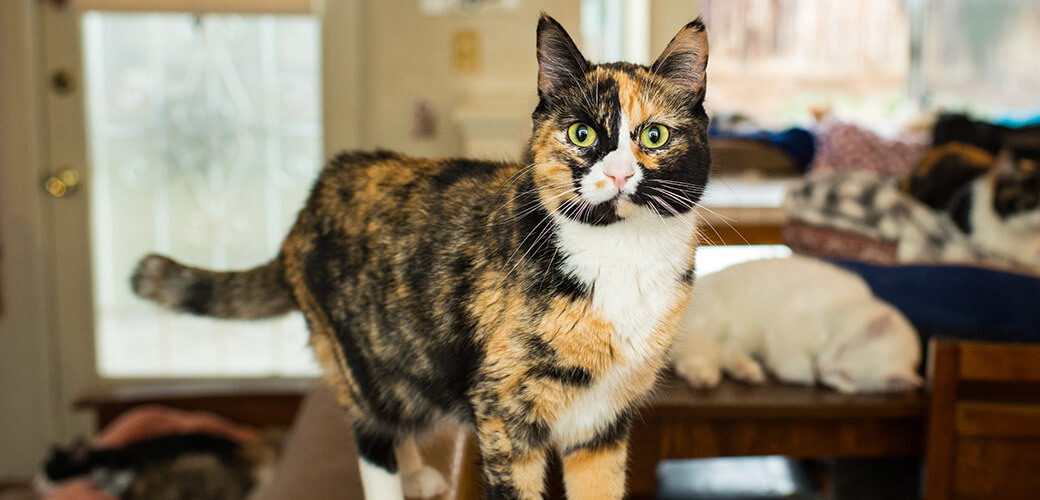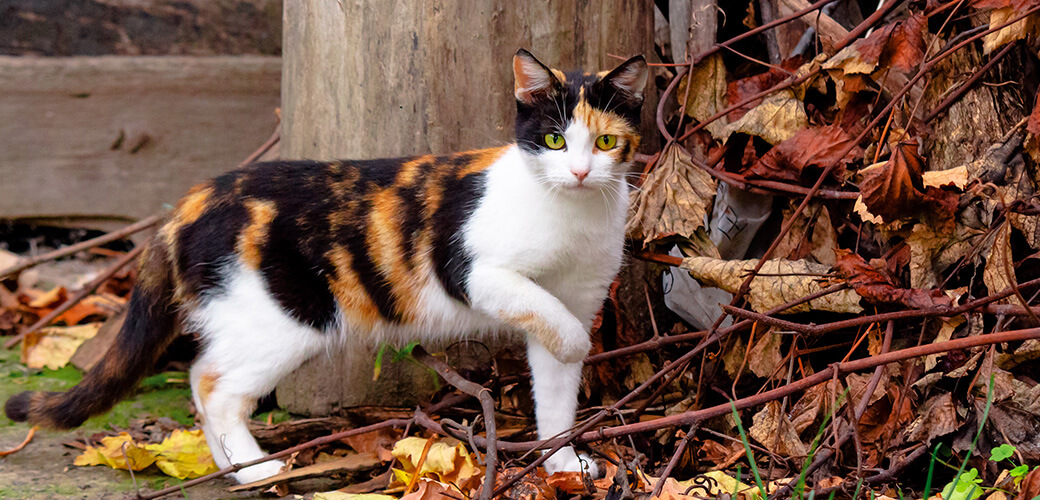In this article, we will look at calico cats in detail. Are all calico cats female? Are they the same as tortoiseshell cats and what gives them their famous calico coloration?
If you have been thinking about getting a calico cat for a while then make sure you read on to see if they will make a perfect pet for you and your family. We’ll look into the calico cat personality, pattern styles and cost of owning – we’ll also answer your most commonly asked questions.
By the end of this article you will have learnt everything you need to know about calico cats.
Read on to find out what makes them so unique…
What is a Calico Cat?

The best way to start this article is to kick off by answering the most commonly asked question…just what is a calico cat and how does it get its unusual coloring?
Is calico a breed of cat?
The calico cat isn’t a cat breed, in fact, they just get their name from their coloring. Widely recognized as one of the world’s most vibrant cats, this type of cat has really unique coloration. These domestic cats usually have patches of orange, black and white, but this can vary in vibrancy (which is something we will talk about below).
It can be difficult to tell the difference between a calico cat and tortoiseshell cat as they have similar coloring but the easiest way to tell them apart is the pattern, as torties tend to have a tri color coat but in a woven pattern and calicos tend to have distinct color patches. Also tortoiseshell cats don’t tend to have white in their coats.
What makes a calico cat?
A male calico cat is a rare thing indeed, with over 99.9% calico cats being female cats. Pretty strange? Not when you look at the science.
The science behind calico cats…
The job of the X and Y chromosomes (sex chromosomes) is to determine whether a cat will be born male or female. The X chromosome carries the gene which creates black and orange coloring. Female cats naturally have two color coding X chromosomes – if a male cat with black genes mates with a female cat with black genes then the outcome is…a black cat! Now if a cat is created with an orange X chromosome and black X chromosome then it will be born with the calico coloring.
Appearance of a Calico

The tricolor cat has a beautiful appearance with patches of white fur and black and orange colors. Calico patches can really vary from cat-to-cat which means that these cats often look very distinctive. The tri color coat and calico patches can cover the entire body of a cat or just small areas. Most calicos have white fur and orange fur patches with black but in some rarer cases, calicos can also have coats with cream shades, chocolate brown, blue black and red.
A dilute calico is a calico but with with much softer tones. Usually primarily white in color they normally have patches of lighter colors of cream, strawberry blonde and blue-gray.
Calico Cat Facts
Here are some fascinating facts about calicos…
- Male calicos are rare – like super rare! It’s crazy to believe, but it is estimated that 1 in every 3,000 calicos are male calicos
- Calico cats are considered a lucky cat – Japanese sailors brought calicos back on their ships to protect them from storms
- In the US calicos are sometimes called “money cats” because they are said to bring financial abundance
- A calico cat’s tail can cure warts! According to Irish folklore, rubbing the tail of a calico cat on your warts will cure you of your ailment – we just feel bad for the poor cat!
- Maine, Massachusetts, and Maryland have an a calico as their official state cat
- Nearly all male calico cats are sterile, due to their chromosome makeup (XXY) which causes health issues and sterility
FAQs:
Q: Is a calico cat rare?
A: There isn’t a single breed of cat that is “calico” – lots of different cat breeds can be calico and the coat color patterns and coat colors can be found in many distinct breeds. It isn’t unusual to see a long-haired calico cat, calico maine coon, calico persian cat, as well as American shorthair, Cornish rex and Devon rex cats. Pointed breeds such as siamese and Russian blues do not get the same markings.
Though these cats do exist, they are in fact very rare, especially male calico cats with 1 in every 3,000 calicos being male cats.
Q: What’s another name for a calico cat?
A: Calico cats have lots of different names around the world. They can be referred to as a tricolor cat, maneki neko cat, patches cat, brindle and clouded tiger.
Q: Are calico cats friendly?
A: Calico cats have a reputation for being sassy! But it’s likely to be coincidental as calicos are not a breed, the coloration can just occur in certain breeds. The personality of a cat can be greatly influenced by breed type so you can expect calico Persian cats to be more laid back, and cats such as the Devon rex and Cornish rex to be more active and occasionally cheeky! There is no sure way to determine the personality and friendliness of your calico cat. If they have been adopted from a rescue and were previously living their life as a feral cat, then obviously you might have a little wild beast to tame! But if you have a calico kitten from a reputable breeder and they have been adequately socialized then your cat may well become a soft, purring lap cat!
Q: Are all calico cats female?
A: Most calico cats are indeed female, with only 1-3,000 calicos being male cats. The tri-coloring is due to the X chromosome and two X chromosomes are needed to make a calico cat with a tri-color coat. Two XX chromosomes also creates a female cat. One orange-coded (X) chromosome paired with one black-coded (X) chromosome will create a calico cat. The white patches occur when the female cat also inherits a gene which is unrelated to the X and Y chromosomes.
Approximately 1-3,000 cats have an extra X chromosome – this is called Klinefelter’s Syndrome or XXY Syndrome. These cats will be male and always sterile. They can also suffer from health problems and have a lower life expectancy.
Q: How much is a calico cat worth?
A: Similar to the question regarding the personality of a calico, there is not one correct answer. The price of a calico can vary quite dramatically from $200 up to $2000. The price will be dependent on the breed of the cat, for example a main coon calico or British shorthair calico will be significantly more expensive than a domestic calico.
When you are thinking of buying or adopting a calico, it’s always important to factor in the cost of food, cat litter, cat toys and the biggest and mostly unavoidable expense – veterinary bills. We always recommend having good pet insurance for any pet that you decide to welcome into your home.
Q: How long do indoor calico cats live?
A: A domestic calico cat that spends its life indoors can live up to 12-16 years. A male calico may not live as long unfortunately. Because male calicos are so rare, they are susceptible to health conditions which might effect their life expectancy.
The life span of a cat also depends on how well you care for them. With lots of play time and high-quality cat food, healthy cats can live happy long lives.
Q: Can calico cats get pregnant?
A: Yes! Calico cats are more than capable of having babies. Calico cats cannot be bred however, and this means that the chances of female calicos having calico kittens is very slim. For a calico female to give birth to a calico kitten she would have to mate with a male calico and they are rare – 1 in every 3,000. On top of that, male calicos are nearly almost always infertile, so they would have to find an even-rarer mate to create calico kittens – good luck with that!
Conclusion
Calicos are special because they can’t be bred. So these beautiful cats are just a wonder of nature. Their fur patterns and coloring can vary so dramatically and different cat breeds can inherit this coat pattern too. Unlike the domestic tabby cat, calicos can have a very unusual appearance.
Calicos have a reputation for being feisty and we don’t think that’s fair! Like any other domestic cat, their personalities can vary. If you are opting for a calico breed – such as a calico main coon then it easier to predict what their temperament will be like. But generally speaking, people love calico cats for their gentle and loving nature.
Complicated genetics are involved in the making of a calico, and we think that this makes them all the more special.

